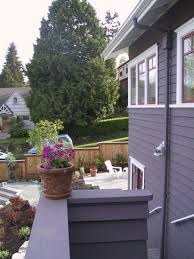best exterior paint colors for brown roof

Exterior Siding IdeasFresh ExteriorHouse S ExteriorExterior SolutionHouse ExteriorsExterior DesignSiding DesignSiding OptionsBrick ExteriorForwardbest house color to go with dark brown roof - Google SearchRoof BlueRoof NavyRoof GreyRoof BlackDark RoofRoof WhiteExterior ColorsExterior IdeasSiding IdeasForwardWanting this color of house with our new brown roof (hoping the color of the roof is what I was wanting...)Pick the Perfect Color for Your House Choosing the right color for the exterior of your home is no easy task. No matter your taste and the style of your house, be inspired by these beautiful combinations. This charming cottage-style home is partially shielded from the street by a beautiful gated fence and landscaping. The color on the walls of the house offers a fresh blue-green backdrop for the lush array of colorful flowers. The reddish-brown door blends nicely with the brick accents on the fence posts and walkway. Try new paint colors! Cottage-style front door ideas.

Colonial Revival: Pleasing Mix An attractive combination of colors and textures comes together effortlessly on this Colonial Revival home. A warm blue-gray color on the upper half contrasts beautifully with white below. Exposed wood shingles on certain standout features create a nice focal point, while crisp, white trim ties everything together.
where can i get christmas cake decorations Exclusive: Get our best curb appeal ideas.
cheap decorating for christmas Craftsman: Fresh Earth Tones
best paint for outdoor basketball court This attractive home features a fresh spin on the earth tones that help define the Craftsman style. Arts and Crafts homes typically work well with colors that reflect the style’s emphasis on natural materials and organic colors.

Here, well-coordinated greens with cream trim add to the home’s relaxed, timeless curb appeal. Browse Craftsman-style home ideas. See beautiful Craftsman front doors. Classic red brick walls lend rustic charm to Tudor-style homes. Historically accurate, the stucco cladding the center gable is painted creamy white and paired with brown framing. Learn how to pick the right type and amount of exterior paint. Browse storybook-inspired front doors. Classic colors are tweaked into an up-to-date combination on this cottage-style house. The front door is an especially refreshing off-beat color that single-handedly spices up the home’s neutral palette. Dark trim around the windows matches the roof’s color and provides subtle, but eye-catching, contrast. Get step-by-step instructions for painting your home exterior. Get a Colorful Front Door Boost curb appeal and show your color personality with a bold front door. Here are a few of our favorite looks.

The warm, sophisticated neutrals and red accents blend beautifully in this Victorian-style house. The ruby red-painted door provides the scheme with a deep contrasting color that’s picked up again on the trim below the cornice, making a great color connection. The aesthetically pleasing beige and brown scheme works particularly well on this sprawling ranch-style home because so much surface area is exposed to the street. Natural stone adds texture to the facade, while the roof, front door, and garage door work in agreement with the trim. Traditional: White and Bright This traditional Low Country home features a classic white field color with bright accents. Pale blue shutters and a sunny orange door are a fresh and unexpected break from tradition. The deep blue of this Georgian-style home is a strong and inviting color. Clean, white trim adds contrast, and a wooden door pops out and acts as a focal point for the perfectly balanced architecture. Browse beautiful traditional front doors.

Eclectic: All in the Details A neutral palette is perfect for this eclectic-style house because of the details, such as divided-light windows, a columned portico, and lots of texture. The brick walls are painted a slightly darker shade of gray than the shingled gables, offering subtle contrast. The welcoming red door provides a punch of color. This charming cottage-style home features a pleasing mix of earthy colors and textures. Dark-stained shakes blend nicely with the natural stone chimney while small doses of white provide contrast. Cutout patterned shutters painted dark green add color and detail. Mediterranean: Sunny Earth Tones The use of sun-inspired colors on stucco walls lends casual elegance to Mediterranean-style homes. Here, warm terra-cotta on the walls partner with earthy browns and greens on the trim and shutters for a welcoming combination. Browse worldly influenced front doors. Why fix what isn’t broken? The classic white-and-black combination on this traditional farmhouse sweeps you away to another place and time.

A small break from tradition, the black door is a nice, unexpected touch. Pictures of farmhouse front doors. Dutch Colonial: Warm Neutrals The sophisticated combination of gray, black, and white on this classically handsome Dutch Colonial-style home creates a feeling of harmony that is restful to the eye. White trim and a dark front door and shutters partner effortlessly with the warm gray walls. The gray works well against the natural stone chimney because it offers contrast while still blending beautifully with the grout. English Cottage: Contemporary Colors This English country cottage is updated with a contemporary color scheme of warm grays. The home shows how opting for a light field color and dark trim can have a pleasing effect. The welcoming entryway is painted the same color as the trim, and the door adds a splash of color.Changing the color scheme of your home's exterior is one of the quickest ways to give your house a face-lift, whether you're preparing to list it for sale or just want to increase curb appeal (or both!).

You might be surprised at the number of outside elements at play that you should consider before you choose a color scheme. Things like the hue of your brick chimney (is your brick more orange or brown?), the color your neighbor chose for their house, and your area of the country can all influence a color scheme. Plus, you'll probably have to coordinate at least three colors -- for the siding, trim, and accents. And this is a big investment, so it's not very easy to change if you don't love the end result, making what seems like a simple decision trickier than you might have expected. We talked to paint companies to get information on their bestselling exterior paint colors, then consulted with color specialists on what to consider when planning your own home's color palette. If you have a brown roof, steer toward a warm siding color, like Sherwin-Williams' Avenue Tan. If you have a gray or black roof, you can go cooler -- Olympic's Coast of Maine is a popular choice. Take a step back and observe any other fixed, unpaintable elements on your home's exterior, like copper awnings, stone chimneys, and brick features.

If one house next door to yours is navy-blue and another is white, you shouldn't veer into warm-color territory or paint your house navy-blue or white (no one likes a copycat). Instead, match their home's color intensity. Something like Benjamin Moore's Wedgewood Gray would pair well: It stays in the cool spectrum and doesn't duplicate their selections. You want to have personality but not stand out in a bad way. 3. Don't ignore local cues Beyond the colors on your block, do some research (you can probably just drive around your town!) to make sure your color scheme is historically and regionally appropriate. "Imagine the colors you see on homes in Key West," says Amy Krane, an architectural color consultant. "Pink and turquoise feel natural in a tropical region but would be wholly out of place in the Midwest." 4. Keep scale and depth in mind The color of your home can trick the eye. For instance, painting your home a light color like Benjamin Moore's November Rain can make it seem larger than it is and visually brings it forward to the curb.

Conversely, dark colors can make a home look smaller but more substantial and set back -- Benjamin Moore's Boston Brick has this effect. 5. Test before you commit Always paint a test patch and observe it at different times of day to see how the sunlight affects it. Keep in mind that all colors will always appear lighter on the exterior of your house than on a paint chip in the store. "Natural lighting makes everything appear lighter and brighter," says paint color specialist Kristie Barnett. "Always go darker than you think you'd want." The best colors for trim A house's trim color is easy to overlook if it marries well with the rest of the house but impossible to ignore if the color is even slightly off. Trim that's matched exactly to the siding color can feel flat; dark trim, especially around windows, can make them appear small or oddly framed. 1. Keep it in the family For this reason, a safe bet is to select a trim color two shades lighter or darker from the siding color or to keep it simple with a fresh white or cream shade.

Sherwin-Williams' Panda White and PPG Paints' Oatmeal are popular selections for warm-tone homes; Benjamin Moore's Frostine is an option for cool-hued homes. 2. Use trim to blend Keep in mind that less-attractive elements of your home, like gutters, garage doors, or vents, should be painted the same color as your trim so they blend in. Picking a trim color can be tough, so this is an opportunity to talk to a pro -- see if the paint company you're working with has preselected color palettes based on architectural style or color range. These can be incredibly helpful when matching your trim to your siding. Now for the fun part: accent colors After you've chosen the foundation for your palette -- the siding and trim colors -- it's time to have some fun playing up the accents, like the front door, shutters, and other architectural details. Accent colors present an opportunity to make a statement and differentiate your home from your neighbors' houses. When it comes to front doors, some colors will never go out of style: Behr's Black Lacquer, for instance, or a red door like Glidden's Rusty Red.

Or pick a color that gives a nod to a classic: Something like Sherwin-Williams' Indigo Batik is similar to navy-blue, but the gray undertone is slightly more modern and fresh. Besides coordinating your front door with your siding and trim, when picking a color, consider the interior of your house, says color consultant Barbara Jacobs. "For one of my clients, as soon as you opened the front door, they had a beautiful oriental rug and piece of art," says Jacobs. "We pulled a lilac color from these elements to use on the front door, and it created a stunning impact as you entered their home." Colors like Benjamin Moore's Super Nova and Breath of Fresh Air are unexpected hues that can ooze this effect. Other architectural details can match the front door, but they offer another opportunity to introduce a new hue. Barnett says it's wise to pull other accent colors from fixed elements on the home. "If you have orangey brick on the base of your house, you could do a copper-color shutter," she says.